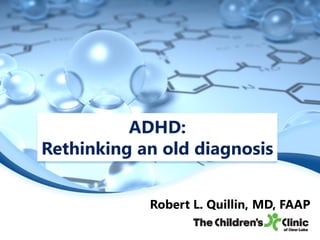The document discusses ADHD, a common neurodevelopmental disorder affecting approximately 11% of children aged 4-17 as of 2011, with diagnoses increasing annually. It covers the financial impact of ADHD, estimated at $36-$52 billion in societal costs, and presents various treatment options, including stimulants and medical foods. It also emphasizes the importance of considering comorbidities and specific nutritional requirements in managing ADHD.




































![Zinc
Acta Med Croatica. 2009 Oct;63(4):307-13.
[The role of zinc in the treatment of hyperactivity disorder in
children].
Dodig-Curković K1, Dovhanj J, Curković M, Dodig-Radić J, Degmecić D.
1University Department of Child and Adolescent Psychiatry, University
Department of Psychiatry, Osijek University Hospital, Osijek, Croatia.
kdodig@yahoo.mail
CONCLUSION: The dose of zinc sulfate used was 55 mg/day, which is
equivalent to 15 mg zinc. The improvement achieved in ADHD children
with the use of zinc sulfate appears to confirm the role of zinc
deficiency in the etiopathogenesis of ADHD. Additional studies are
needed to identify the real and efficient dose of zinc.](https://image.slidesharecdn.com/tapa022114adhdquillin-140222164002-phpapp01/85/Dr-Quillin-on-ADHD-at-TAPA-2014-37-320.jpg)
![Vitamin D
Pediatr Int. 2014 Jan 13. doi: 10.1111/ped.12286. [Epub ahead of print]
Vitamin D Status in Children with Attention Deficit Hyperactivity
Disorder.
Goksugur SB1, Tufan AE, Semiz M, Gunes C, Bekdas M, Tosun M, Demircioglu F.
1Department of Pediatrics, Medical Faculty, Abant Izzet Baysal University, Bolu,
Turkey.
CONCLUSION: 25-OH-vitamin D level in ADHD group and control
group was respectively; 20.9±19.4 ng/mL and 34.9±15.4 ng/mL
(p=0.001). Our results suggest that there is an association between
lower 25-OH-vitamin D concentrations and ADHD in childhood and
adolescence.](https://image.slidesharecdn.com/tapa022114adhdquillin-140222164002-phpapp01/85/Dr-Quillin-on-ADHD-at-TAPA-2014-38-320.jpg)

